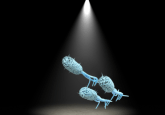Primordial protein translation

Ribosomes can function with iron or manganese ions in place of magnesium, recent results show, providing an insight into the evolutionary history of protein transcription.
A recent study that set out to investigate the early development of ribosomes – highly conserved complexes present in all life – and their interactions with different ions at the dawn of life has come to a conclusion. The study, led by Loren Williams of the Georgia Institute of Technology (GA, USA), found that today’s ribosome could function using manganese and iron ions as opposed to magnesium.
The ribosome today relies on magnesium as an integral part in maintaining its structure and acting in the catalytic activities of its function: protein translation. However, when life first began to evolve, the Earth’s atmosphere was a significantly different composition to the one we experience now. Breathable oxygen was non-existent, and iron and manganese were abundant while magnesium was less readily available than it is today.
To study the ribosome, Marcus Bray (Georgia institute of Technology) incubated them in a special chamber with an atmosphere, mimicking primordial earth, containing no oxygen and a high level of one of magnesium, iron or manganese. This induced the ribosomes to incorporate the ion present in the chamber into its structure.
The research team was highly expectant of the ribosomes failure in the iron and manganese chambers. “I thought, ‘It’s not going to work, but we might as well try the moonshot’,” explains Williams. “The number of different things magnesium does in the ribosome and in the translational system is just enormous. There are so many types of catalytic activities in translation, and magnesium is involved in almost all of them.”
The team was stunned, however, to find that when they tested the translational efficiency of the ribosomes with iron ions incorporated into their structure, they were functional and between 50-80% as efficient as those incubated with magnesium while the manganese incubated ribosomes proved to be even more efficient than the iron-based ones.
The team found that in addition to the replacement of the ions in the ribosome, the usual cloud of magnesium ions that surrounds the ribosome is also replaced, and still the ribosome is able to function.
These results provide a great insight into the evolution of the transcriptional process but also leads to a vital change in the current perception of ribosomal mechanics, which could be invaluable in future studies regarding ribosomes. “I think these may be textbook-rewriting results since the whole field of ribosome research involves magnesium. Now it’s no longer the case that only magnesium works,” hypothesized Bray.


